Anticipating the New iPhone: A Comprehensive Overview
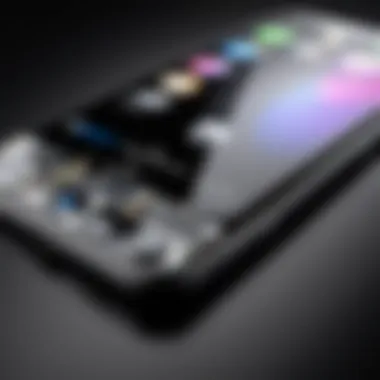
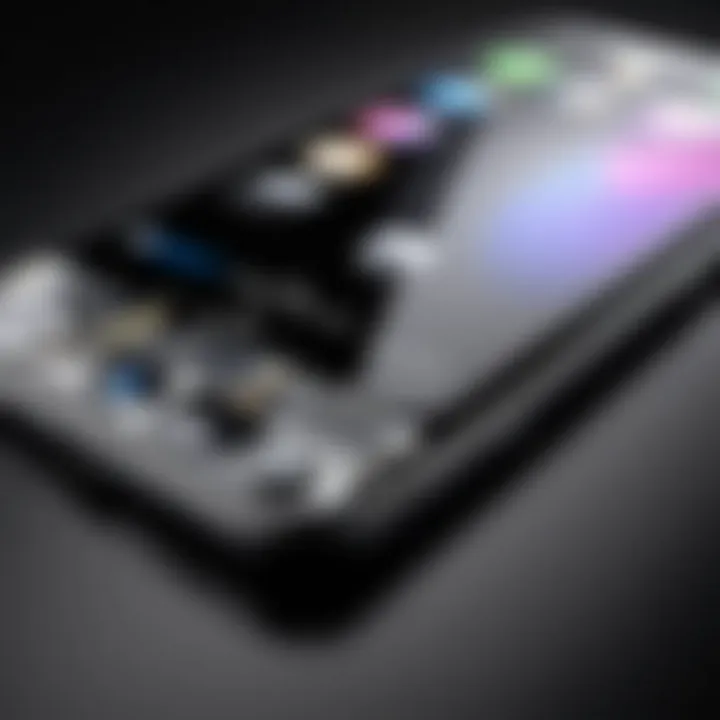
Intro
The tech world is abuzz with anticipation as rumors circulate regarding the upcoming release of the new iPhone. Each year, Apple manages to generate substantial excitement surrounding its flagship product. This article aims to provide a detailed look at what the new device is expected to feature, as well as how it will perform in today’s competitive smartphone market.
In this exploration, we will discuss the technological specifications, unique selling points, and the overall design and build quality of the new iPhone. Additionally, we will analyze how it aligns with current consumer preferences and trends, equipping readers with the necessary insights to understand the possible market implications. Keep reading to see what is likely to be unveiled in the next Apple event and how this new device could redefine user experiences in several key areas.
Preamble to the New iPhone
The launch of a new iPhone captures the attention of both consumers and technology enthusiasts alike. It signifies not just an upgrade to a product, but also an evolution in mobile technology. With each release, Apple presents advancements that often set benchmarks in the industry. Understanding these upcoming changes is critical for both potential buyers and industry analysts.
The new iPhone is expected to bring several significant features that could redefine user experience. These enhancements are not merely cosmetic; they encompass performance upgrades, improved camera systems, and possibly, new software capabilities. Potential consumers must recognize how these innovations fit into their daily lives. For instance, features like battery life and processing power can greatly influence purchase decisions.
Moreover, the importance of the new iPhone extends beyond individual consumers. It reflects broader technological trends and competitive dynamics in the smartphone market. As Samsung, Google, and other competitors continuously innovate, Apple's response will be scrutinized. The new iPhone plays a dual role, meeting consumer needs while also making strategic moves in the market.
In this article, we will explore various aspects that define the upcoming iPhone. From technological advancements to market positioning, our goal is to provide a comprehensive overview. The insights and analyses within these sections aim to equip readers with a deeper understanding of what the new iPhone represents in an ever-evolving tech landscape.
"With each iteration of the iPhone, Apple not only enhances its product line but also reshapes consumer expectations within the tech industry."
This examination will hopefully engage tech-savvy individuals and gadget lovers who seek clarity on how the new iPhone might impact their choices or the technology sector as a whole. By focusing on substantial and relevant details, we will move beyond surface-level features to address their implications.
Historical Context of iPhone Releases
Understanding the historical context of iPhone releases is crucial in grasping the significance of the upcoming model. Each generation of the iPhone has not only reflected the technological advancements of its time but has also shaped consumer expectations and market dynamics. By examining previous releases, we can contextualize the innovations anticipated in the new iPhone and appreciate how Apple has consistently pushed the boundaries of smartphone design and functionality.
The iPhone has undergone significant transformations since its inception in 2007. Every model has introduced new features that catered to the changing needs and desires of consumers. The journey from the initial iPhone with its modest camera and basic app functionality to the current era, where devices are equipped with advanced capabilities, highlights a relentless pursuit of excellence and user satisfaction.
Evolution of the iPhone Series
The evolution of the iPhone series illustrates a remarkable path of innovation that has continuously captivated users. It all started with the original iPhone, which revolutionized the way people interacted with mobile devices. Subsequent models introduced features such as the App Store, enhanced camera systems, and increasingly powerful processors. Each iteration has built on the successes and shortcomings of its predecessor, resulting in a cohesive narrative of technological progress.
- First Generation (2007): Launched without an App Store, setting the stage for app-centric mobility.
- iPhone 4 (2010): First significant redesign with a sleek glass body and Retina display.
- iPhone 6 and 6 Plus (2014): Addressed the market shift toward larger screens.
- iPhone X (2017): Marked a radical redesign with facial recognition and no home button.
- iPhone 12 series (2020): Reintroduced flat edges and 5G capability, reflecting current tech trends.
This evolution highlights how Apple not only adapted to but also often anticipated market demands and technological advancements.
Milestones in Technological Advancements
Several milestones in technology have influenced the development of each iPhone generation. Key advancements include:
- Introduction of Touch ID and Face ID: These biometric security measures revolutionized user authentication, providing convenience while enhancing security.
- Camera Technologies: From basic photography to advanced computational photography, camera capabilities have expanded, allowing users to capture professional-quality images.
- Performance Enhancements: The introduction of custom chips like the A-series has consistently improved speed and efficiency, pushing mobile computing boundaries.
- Wireless Technologies: Transitioning from 4G to 5G exemplifies Apple's commitment to keeping its devices at the forefront of connectivity trends.
"The development of the iPhone has been marked by a series of innovations that not only meet user needs but also shape the future of smartphone technology."
Each milestone reflects a response to consumer demands and an understanding of emerging technologies. The historical context serves not only as a foundation for upcoming features but also reveals how the new iPhone is poised to set yet another benchmark in the smartphone industry.
Expected Features of the New iPhone
The expected features of the new iPhone hold significant interest for consumers and tech enthusiasts alike. Understanding these features is essential, as they often determine a device's usability, desirability, and overall impact in the competitive smartphone market. These features represent not just incremental advancements but also reflections of consumer demand and technological evolution.
Design Specifications
Design plays a vital role in user experience. The anticipated design specifications for the new iPhone likely revolve around a more streamlined form factor coupled with enhanced materials for durability and aesthetic appeal. Expectations include thinner bezels, lighter weight, and perhaps new color options that resonate with current trends. The integration of better screen technology, such as ProMotion displays, could enhance visual performance, making it more enjoyable to use for both casual and demanding tasks.
Moreover, ergonomics must not be overlooked. Apple has consistently focused on creating devices that feel comfortable in one’s hand and provide intuitive access to features. This iteration may incorporate feedback from users of previous models, potentially leading to a refined user interface that supports seamless interaction with the hardware.
Camera Enhancements
The camera holds significant weight in the purchasing decisions of modern smartphone users. Expected camera enhancements for the new iPhone are anticipated to include improvements in low-light performance, increased resolution, and advanced computational photography features. This aligns with Apple's trend of making photography accessible to everyone, regardless of expertise.
Expectations also suggest the introduction of new lenses or upgraded sensors that would widen the camera's ability to capture different perspectives. Enhanced video recording capabilities, perhaps with improved stabilization and 4K resolution, could further elevate content creation, catering especially to users who prioritize videography.
Processing Power and Performance
At the core of the new iPhone's efficiency will be its processing power. With the potential introduction of a new chip, possibly the A17 Bionic, performance enhancements are crucial. This chip is expected to offer a noticeable increase in speed and power efficiency compared to its predecessors. Such advancements would not only facilitate smoother multitasking but also enable developers to create more complex applications that leverage the full capabilities of the device.
Additionally, enhanced graphics processing could lead to improved gaming experiences and more immersive applications, an area that continues to be a primary focus for Apple. Optimized performance could significantly boost user satisfaction and position the iPhone favorably against its competitors.
Potential Battery Life Improvements
Battery life remains a constant concern for smartphone users. Anticipated improvements in battery life for this new model may come from a combination of hardware efficiency and software optimization. The new chip is likely designed to consume less power, even during demanding tasks. Alongside this, possible advancements in battery technology may contribute to an extended lifespan between charges.
Furthermore, features like optimized charging and energy management systems could ensure that users get more out of their devices without frequent recharging. With hectic lifestyles and increasing demand for mobile connectivity, these enhancements would be welcome additions that reflect consumer priorities.
"In an era where technology never sleeps, extended battery life is no longer an option but a necessity for the modern user."
Through these expected features, the new iPhone aims not only to satisfy current consumer expectations but also to set benchmarks for future devices. The careful blend of design, camera innovations, processing power, and battery enhancements together position the new device as a strong contender in the competitive landscape of smartphones.
Software Innovations
Software innovations are critical to the overall experience of any smartphone, and the new iPhone is expected to elevate this aspect significantly. As mobile technology evolves, software plays a pivotal role in the performance, usability, and versatility of devices. There are several key elements to consider in this section, particularly the integration of new operating system features and how the iPhone aligns with other Apple services.
New Operating System Features
The forthcoming iPhone is likely to launch with the latest version of Apple's operating system, iOS. This update usually brings several enhancements that are not just limited to aesthetics but also functionality. Users will find improvements in navigation, security, and app management, which can directly affect daily use.
Among the anticipated features are improved privacy settings that restrict app data access, enhancing user control over personal information. The integration of advanced machine learning capabilities may also enable more personalized experiences, such as predictive text and smarter Siri responses. Furthermore, support for widgets and an overall redesign may encourage greater customization, allowing users to tailor their device to their preferences.
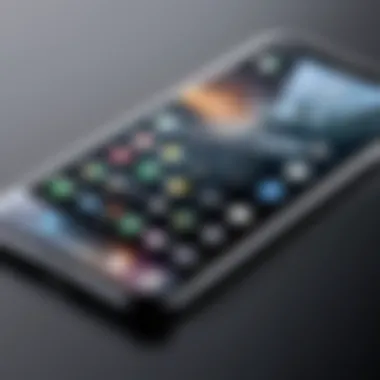
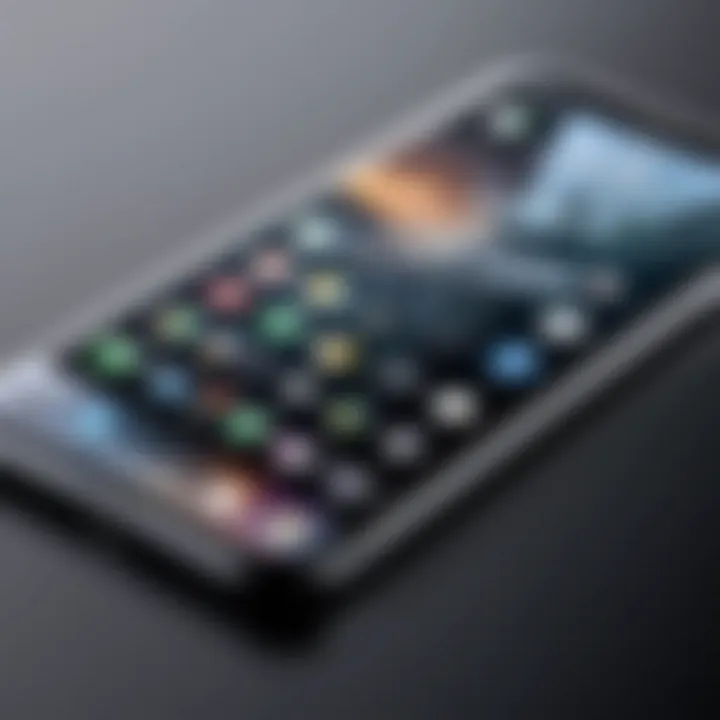
Another significant aspect is the potential for enhanced performance optimization. Users may see faster app launches, reduced lag during multitasking, and improved battery management thanks to the software's ability to adapt to user habits.
Integration with Other Apple Services
Apple's ecosystem is known for its seamless connectivity between devices and services. Software innovations in the new iPhone will likely extend this integration, enhancing the overall user experience. Features such as Universal Clipboard and Handoff are expected to be more refined, allowing users to start a task on one device and continue it on another without interruption.
Additionally, the new iPhone could introduce deeper compatibility with services such as iCloud, Apple Music, and Apple Pay. This would not only streamline tasks but also add layers of functionality, making it easier to manage files, access music anywhere, or make transactions securely and efficiently. As aspects of convenience and synergy become more prudent for consumers, the integration of services will likely set the new iPhone apart in a competitive marketplace.
"The integration of Apple services is more than an advantage; it is essential for a cohesive experience that drives user satisfaction."
Overall, the software innovations within the new iPhone will be crucial in determining how effectively it meets consumer needs in terms of performance, usability, and connection to the broader tech landscape.
Market Position and Target Audience
Understanding the market position and target audience of the new iPhone is crucial as it directly informs both consumer expectations and Apple’s marketing strategy. By dissecting these elements, this article aims to illustrate how the new iPhone aligns with current trends and consumer desires in the highly competitive smartphone landscape. Insight into market positioning reveals how Apple not only differentiates itself from rivals but also how it continues to cater to specific user demographics while maintaining a luxury brand image.
Audience segmentation plays a significant role in this aspect. Apple consistently targets tech-savvy individuals, gadget enthusiasts, and early adopters. By focusing on these segments, Apple's marketing can be tailored to address specific needs, such as high processing power for gamers or enhanced camera features for photography lovers.
Additionally, recognizing the particular age demographics, lifestyle preferences, and purchasing power of potential customers is imperative for effective marketing campaigns.
Demographic Insights
The audience for the new iPhone encompasses a wide range. However, specific demographic insights reveal distinct groups predominantly interested in purchasing the device:
- Age Group: Many current iPhone users are between 18 and 35 years old. This age group often prioritizes features like social media capabilities, gaming specifications, and overall design aesthetics.
- Income Level: The new iPhone typically appeals to middle to high-income consumers. Higher price points often signal quality and status, reinforcing brand loyalty among affluent users.
- Tech Enthusiasts: Users who follow technology trends closely often comprise a significant demographic. This group is primarily concerned with features, specifications, and integrations with other tech ecosystems.
- Global Reach: While the iPhone is widely used in North America and Europe, emerging markets in Asia and Africa show a growing interest. Understanding cultural differences in technology adoption, like the preference for dual-SIM capabilities in some regions, can influence Apple's strategies.
Competitor Analysis
The smartphone market is distinctly crowded, with numerous brands vying for consumer attention. Competitor analysis is essential for understanding where the new iPhone stands relative to its rivals. Brands such as Samsung, Google, and OnePlus offer formidable competition, especially in value for money and feature sets.
- Samsung: Known for its Galaxy series, Samsung emphasizes display technology and camera capabilities. Recent releases have increased pressure on Apple to offer superior camera enhancements and display adjustments.
- Google: The Pixel line resonates well with users interested in photography. Google's continual focus on software improvements and AI features sets it apart and challenges Apple in usability and camera performance.
- OnePlus: With budget-friendly options that boast high performance, OnePlus positions itself strongly among tech enthusiasts who seek value without sacrificing quality.
An in-depth competitive landscape encourages Apple to innovate, ensuring that it retains its customer base while attracting new users. By understanding these competitors, we can anticipate the strategic decisions Apple may make to enhance market positioning with their upcoming products.
Consumer Expectations and Speculations
The segment of consumer expectations and speculations holds a critical place in this article. It reflects the collective anticipations of users as they await the next iPhone release. Understanding this topic is paramount. It not only guides manufacturers on what features to prioritize but also shapes how potential buyers evaluate the device’s value proposition. Integrating feedback from prior models offers manufacturers insights into user preferences and common pain points. This analysis can help create a product that meets and even exceeds expectations.
Feedback from Previous Models
User feedback from previous iPhone releases can significantly influence consumer expectations for the upcoming model. Those feedbacks often highlight aspects such as performance, battery life, camera abilities, and overall user experience.
Key Considerations from User Feedback:
- Performance Issues: Many users expressed a need for improved speed, especially in multitasking.
- Battery Life Concerns: Battery longevity continues to be a common point of critique. Users desire phones that can sustain activity throughout the day.
- Camera Quality: With photography being a major selling point, feedback regarding low-light performance and image stabilization has been particularly insightful.
- Design Preference: Customers often discuss their views on design aesthetics, materials used, and ergonomics.
This feedback is crucial as it helps manufacturers identify essential features that resonate well with users.
Rumors and Leaks Online
Rumors and leaks surrounding the new iPhone have become part of the smartphone culture. Fans frequently scour the internet to piece together hints about upcoming features, often from credible tech blogs, social media platforms, and forums like Reddit.
Common Sources of Speculation Include:
- Insider Information: Employees or ex-employees may leak information about the product specifications or launch events.
- Supply Chain Insights: Changes in production schedules or components can suggest new features or delays.
- Patent Filings: New patents can hint at innovations the company is planning to introduce.
"The anticipation built by online leaks can elevate consumer excitement and influence purchasing decisions."
The blend of anticipation and speculation provides a dynamic discussion platform among tech enthusiasts, thus amplifying interest in the new iPhone.
Impact of Emerging Technologies on the New iPhone
The intersection of emerging technologies and smartphone advancements is pivotal in shaping the next generation of mobile devices. As we anticipate the new iPhone, understanding how these technologies will influence its features and performance is essential. The integration of cutting-edge innovations not only enhances user experience but also adjusts consumer expectations in a competitive market. The emphasis on capabilities like artificial intelligence and 5G is no longer optional; it is a necessity that tech-savvy consumers now demand from their devices.
Artificial Intelligence Integration
Artificial intelligence is redefining how users interact with their devices. The coming iPhone is expected to leverage AI to offer more personalized and intuitive experiences. From improved photo enhancements that optimize images in real-time to smarter virtual assistants, the role of AI will be crucial.
Consider the following benefits of AI integration:
- Improved User Interaction: Features like predictive text and contextual recommendations will elevate the way users communicate and manage tasks.
- Enhanced Security: AI can analyze patterns in user behavior, strengthening the device’s security measures and personalizing the privacy settings according to user preferences.
- Optimized Performance: Machine learning can help allocate resources more effectively, which will enhance the device’s performance in demanding applications.
Emerging AI applications are increasingly capable of functioning independently. This functional autonomy reduces dependency on user input, presenting opportunities for multitasking and efficiency.
5G Network Capabilities
The rollout of 5G networks will fundamentally alter the smartphone landscape. For the upcoming iPhone, incorporating 5G technology is essential for maintaining relevance and competitiveness. This technology promises faster data speeds and reduced latency, radically changing how users consume content and engage with applications.
Key aspects of 5G network capabilities include:
- Faster Download and Upload Speeds: Users can download high-resolution movies or large files in seconds, facilitating seamless content consumption.
- Real-Time Data Access: Enhanced connectivity enables smoother video conferencing and gaming experiences, important for professionals and gamers alike.
- Smart Device Connectivity: 5G facilitates more reliable connections with the growing number of IoT devices, enhancing the overall smart home environment.
With the adoption of 5G, the new iPhone will not only improve user experience but also expand the possibilities for new apps and services. This capability will set the standard in a fast-evolving tech landscape.
"The future of smartphones hinges on the integration of AI and 5G, marking a shift from mere devices to essential lifestyle tools."
In summary, the impact of emerging technologies like artificial intelligence and 5G is significant for the new iPhone. Not only do they promise an improved user experience, but they also suggest a robust performance structure that will cater to the diverse needs of modern consumers. Understanding these elements will help buyers make informed decisions about the forthcoming release.
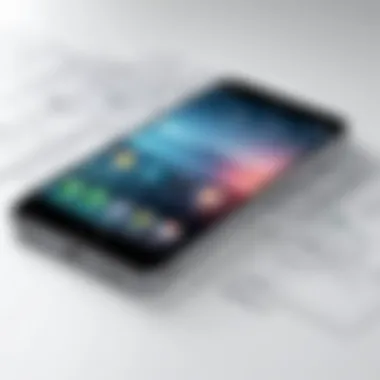
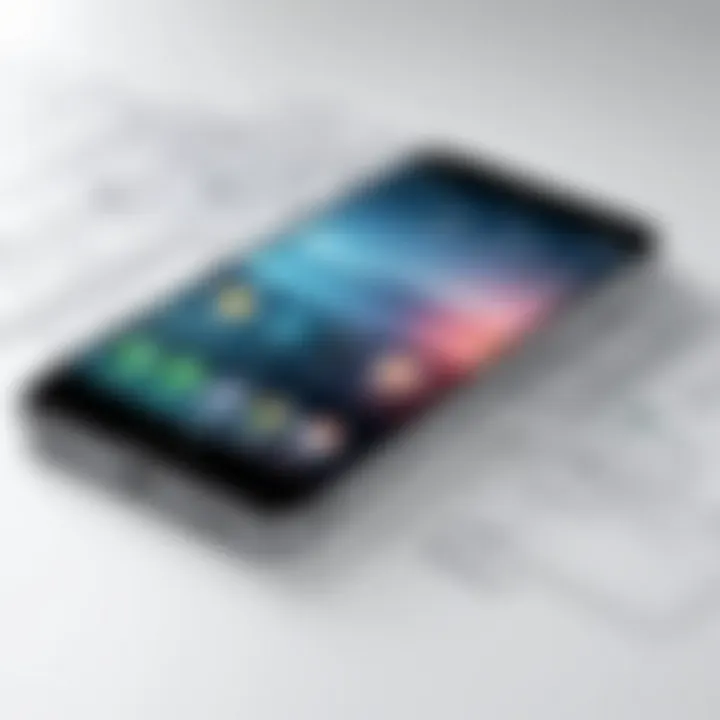
Trade-offs and Limitations
Understanding the trade-offs and limitations of the new iPhone is crucial for potential buyers. Each device brings advancements, yet these improvements often come at a cost. This section examines specific elements that influence the decision-making process when considering the latest iPhone model. It also delves into benefits and drawbacks, providing a comprehensive view of what to expect.
Potential Performance Bottlenecks
One major area of concern for users is potential performance bottlenecks. The new iPhone may feature cutting-edge technology, yet limitations in various components can impede optimal performance. For instance, while the new processing chip, believed to be the A17 Bionic, promises enhanced speed and efficiency, a close analysis reveals that other aspects, such as RAM capacity or software optimizations, could potentially hinder the overall user experience.
The trade-off here primarily arises from balancing power efficiency and heat generation. While trying to maximize battery life, Apple may opt for less aggressive performance boosts which can lead to moments where multitasking or graphics-heavy applications struggle. Users who frequently push their devices to the limit for gaming or video editing may notice these bottlenecks more than average consumers.
Design Constraints
Design constraints pose another challenge for the new iPhone. Sleeker designs often come with sacrifices in other areas. While aesthetics are important, thinness often limits battery size, placing a constraint on longevity. Furthermore, a reduction in device weight and size may necessitate the use of specific materials that do not offer the same level of durability as previous, bulkier designs.
Additionally, choices like the placement of the camera and buttons can impact usability. The trend toward all-screen designs may limit the ergonomics of holding the device comfortably. Here, Apple faces the ongoing challenge of innovating while ensuring user satisfaction. Consumers expect both beauty and functionality, which may not always align.
"The difficult part of technology design is often creating something that looks great while ensuring it still serves its purpose."
Price Considerations and Value Proposition
Understanding the price considerations and value proposition of the new iPhone is crucial for consumers. As smartphone technology continues to evolve, price remains a significant factor for potential buyers. The balance between price, features, and overall user experience can dictate the purchasing decision. In this section, we will explore the expected price range and how the new iPhone compares to its competitors in terms of value.
Expected Price Range
The anticipated price range of the new iPhone plays a vital role in shaping market expectations. Early reports suggest that we can expect the pricing to start at a competitive level that aligns with previous models. Historically, Apple has maintained a tiered pricing strategy, which provides options for both budget-conscious consumers and those willing to pay a premium for enhanced features.
For example, the base model may range from approximately 799 to 999 dollars. Higher-tier variants, equipped with advanced features, could reach even higher price points. This variation allows consumers to choose a model that best fits their financial situation while also supporting their technological needs.
- Price ranges typically include:
- Entry-level model: around $799
- Mid-tier model: around $899 to $1,099
- High-end model: around $1,199 or more
Key Consumer Consideration: Consumers will weigh these costs against the perceived value, including the technological advancements and ecosystem integration that Apple offers.
Comparative Value to Competitors
Evaluating the new iPhone against competitors emphasizes its value proposition. Apple has long been known for its integration of software and hardware, which provides a seamless user experience. When compared to leading smartphones such as Samsung Galaxy series or Google Pixel devices, certain aspects shine.
- Ecosystem Integration: Apple users benefit from an integrated ecosystem, making the transition between devices smoother. Products like the Apple Watch or iPads work with the new iPhone, enhancing overall usability.
- Resale Value: Historically, iPhones have a higher resale value compared to competitors. This can offset the initial expense when upgrading to newer models.
- Quality Assurance: The durability and longevity of iPhones often lead to fewer costs over time regarding repairs and replacements.
"When considering a smartphone, the total cost of ownership, including resale value and accessory compatibility, is a significant factor that reflects the true value of a device."
As the launch approaches, consumers should assess their priorities. For tech-savvy individuals, the benefits of the new iPhone may justify any premium price over other brands. By aligning expected costs with competitive advantages, buyers can make informed decisions, ensuring the new iPhone's value proposition meets their needs.
Launch Event Anticipations
The excitement surrounding the launch event for the new iPhone is palpable and warrants thorough examination in this discussion. The launch serves not just as a platform for unveiling the latest device, but also as a significant marketing and branding opportunity for Apple. This specific occasion draws attention from media outlets, tech enthusiasts, and potential buyers alike. Understanding the nuances of this event helps to contextualize consumer reactions and expectations.
The importance of anticipating what will be presented during the launch event cannot be understated. Firstly, the anticipation itself generates buzz that can lead to increased pre-orders and sales, setting the stage for Apple's financial year. Secondly, the way features are communicated shapes public opinion and influences the competitive landscape among smartphones.
Moreover, each launch is a demonstration of Apple's innovation cycle. The event not only showcases the new iPhone but also aligns it within the broader ecosystem of Apple products and services. By understanding the launch event, readers can better grasp how the new iPhone may offer unique features and enhance the existing user experience within the Apple ecosystem.
What to Expect from the Presentation
Attendees of the launch event can expect a polished presentation that highlights key features of the new iPhone. This includes insights into the design, enhanced capabilities, and significant performance upgrades. Typically, Apple executives present these innovations enthusiastically, generating intrigue and excitement among the audience.
Key elements initially slated for discussion include:
- Camera advancements that improve photography and video capabilities.
- Performance metrics of the new chipset that indicate faster processing and enhanced capabilities.
- Software integrations with features that leverage Artificial Intelligence or advanced cloud services.
Apple often infuses the presentation with live demonstrations to illustrate how these features function in real-life scenarios. This adds an experiential layer that can resonate with potential buyers, making them more likely to adopt the new technology.
Keynote Highlights
The keynote itself often serves as the hallmark of the launch event, delivering critical messages about Apple's vision for the new iPhone. Here are some expected highlights from the upcoming launch:
- Product unveiling: A first look at the new device, including its design and aesthetic improvements.
- Feature demonstrations: Live showcases of the new camera, battery life, and processing functionalities to demonstrate real-world applications.
- Consumer testimonials: Apple may feature feedback from early testers or influencers to validate its claims about the phone’s performance.
- Future prospects: Discussions about how the new iPhone fits into the larger technological trends, such as AI, 5G, and the evolving Apple ecosystem.
Such highlights not only inform consumers about the product but also strategically position Apple products within the tech landscape, solidifying their role as a leader in innovation.
"Each launch is not just an introduction of a product; it's a reaffirmation of Apple's commitment to pushing technological boundaries."
By examining the launch event's anticipations, readers can learn how new developments could impact their purchasing decisions and align with the overall trajectory of smartphone technology.
Comparison with Previous Models
When discussing the new iPhone, it is essential to evaluate its relationship with earlier models. This comparison illustrates developments and advancements that Apple has made over the years. Each iteration of the iPhone has introduced innovations, both in hardware and software. Recognizing these shifts provides better insight into how the new device might perform and what features could be prioritized.
Identifying specific improvements helps consumers understand the value of upgrading. It also shows how Apple adapts to changing technology and user demands. Demand for better performance, enhanced battery life, and advanced features has grown over time. As such, the expectations for each new iPhone release have understandably increased. In this context, the new iPhone is not just a sequel but a response to an evolving market landscape.
Feature Improvements
A key point of consideration in comparing the new iPhone with its predecessors is the notable feature improvements. Historically, Apple has placed emphasis on enhancing camera capabilities, processing power, and overall design. With the new iPhone, one can expect substantial updates across these areas.
- Camera Quality: Previous models have steadily improved camera technology. For example, Night Mode and computational photography became significant in the recent models. The new iPhone may further refine these capabilities, possibly introducing enhanced optical zoom or better low-light performance.
- Processing Power: The new iPhone is likely to sport a more advanced chip. For instance, the transition from the A13 to A14 chip marked a significant leap in processing efficiency and speed. The new model could continue this trend with a next-generation chip that supports faster app performance and improved battery management.
- Display Enhancements: Previous models have featured displays that are both vibrant and responsive. Upgrades in refresh rates or OLED technology could enhance the user experience significantly in the upcoming version.
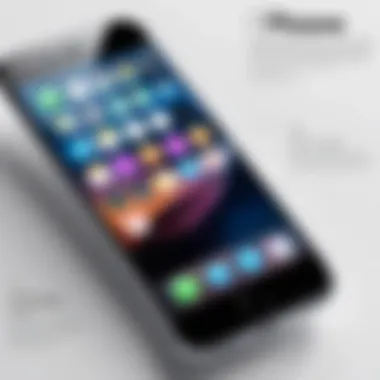
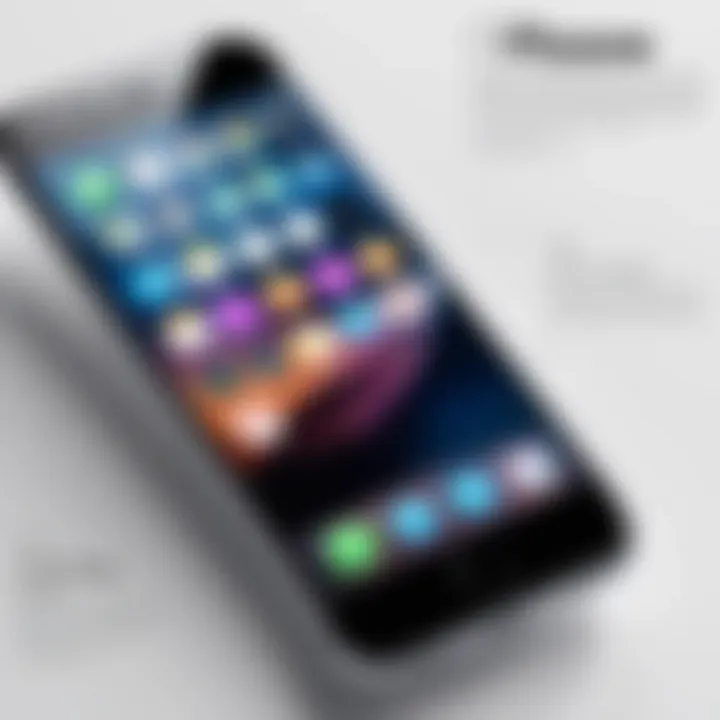
By focusing on these areas, Apple not only meets the current technological standards but also sets new benchmarks. Each upgrade reflects the company's commitment to continual improvement and innovation.
User Experience Differences
Examining user experience is crucial when comparing the new iPhone to past iterations. Over time, Apple has honed its software ecosystem, which interacts closely with hardware. This combination affects how users perceive their devices and what they expect from future models.
- Software Integration: The new iPhone will likely ship with the latest version of Apple's operating system. It is anticipated that this will include features designed for better user interaction and productivity. Improvements such as better Siri integration or enhanced multitasking can significantly shift user experience.
- Ergonomics and Design: Each new iPhone typically introduces refinements in ergonomics. The size and weight of the device can directly impact user comfort and accessibility. The ability of the new iPhone to maintain tradition while innovating in design will be a key area of focus for users.
- User Feedback Implementation: Apple often listens to feedback from its user base. Past complaints regarding battery life or specific design choices have shaped new models. The incorporation of widespread user thoughts into the new design could set it apart significantly in terms of satisfaction and utility.
In summary, the comparison between the new iPhone and its predecessors reveals a trajectory of growth and enhancement. Each feature improvement and user experience difference establishes the new model as a noteworthy advancement in smartphone technology.
Potential Accessories and Ecosystem Integration
The upcoming new iPhone is not just about the device itself but also the accessories and the broader ecosystem that surrounds it. The integration of accessories enhances the functionality, personalization, and user experience of the iPhone, making it a more versatile tool. This section aims to examine the various compatible accessories and the overall benefits of being a part of the Apple ecosystem.
Compatible Accessories
With each new iPhone release, Apple introduces several accessories designed to augment the mobile experience. Some notable accessories include:
- AirPods: These wireless earbuds integrate seamlessly with iPhones and offer high-quality sound.
- Apple Watch: This wearable technology not only complements the iPhone but also enhances health tracking and notifications.
- Cases and Screen Protectors: Various brands and styles provide essential protection for your device, enhancing its durability.
- Charging Docks and Cables: These are vital for keeping the phone powered. They come in different designs, such as wireless chargers, which offer convenience.
- Photography Accessories: Lenses and stabilization tools enhance the camera capabilities of the iPhone.
Choosing the right accessories can greatly impact how users interact with their new iPhone. The compatibility and ease of use among these accessories make them attractive additions, encouraging consumers to invest in Apple's ecosystem.
Apple Ecosystem Benefits
The Apple ecosystem is designed to provide an integrated experience across all devices. The benefits include:
- Seamless Connectivity: Devices such as the iPad, MacBook, and Apple TV connect effortlessly with the iPhone, enhancing productivity and entertainment.
- Continuity Features: Features like Handoff allow users to start on one device and continue on another. For example, if a user is writing an email on their iPhone, they can finish it on their Mac.
- Shared Services: Services like iCloud enable users to store and access their documents, photos, and backups across all devices. This not only adds convenience but also peace of mind.
- Unified User Interface: The design language remains consistent across devices, making it easier for users to switch between products without a learning curve.
- Exclusive Access: Some applications and features are tailored specifically for Apple users, providing unique functionalities that enhance the user experience.
The integration of potential accessories and the benefits of the Apple ecosystem amplify the value of the new iPhone, demonstrating how these elements work together to deliver an enhanced experience for tech-savvy individuals.
User Reviews and Feedback Post-Launch
User reviews and feedback following the launch of the new iPhone play a critical role in shaping consumer perception and influence purchasing decisions. After the initial excitement of a product release settles, detailed evaluations from actual users provide insights into the device's performance, usability, and overall satisfaction. This section unpacks the importance of examining these reviews, the unique experiences of consumers, and the opinions shared by influencers in the tech industry.
Consumer Experiences
The value of consumer experiences cannot be overstated. Users often share their firsthand accounts of the new iPhone’s functionality, including aspects like camera quality, battery life, and overall speed. In the digital age, platforms like Reddit and social media sites allow consumers to voice their thoughts and share reviews easily. This feedback often includes:
- Specific use cases, such as how well the camera performs in low light.
- Observations regarding software updates and their impact on device performance.
- Comparisons with previous models, detailing enhancements or regressions.
Understanding consumer feedback helps potential buyers make informed decisions. For instance, if many posts highlight issues with battery life, this may prompt buyers to reconsider their purchase. Additionally, diverse experiences can illuminate aspects not covered in official reviews, offering a well-rounded view of the product’s strengths and weaknesses.
Influencer Opinions
Influencers in the tech world often have wide-ranging audiences and can substantially impact consumer opinions. Their reviews are usually more polished and often attract considerable attention. Influencer feedback often covers:
- In-depth analyses of features, such as the capabilities of the new iPhone’s camera versus competitors.
- Evaluations of ergonomics and design, influenced by hands-on use.
- Anticipated longevity and software support of the device.
Many influencers will also provide video content that demonstrates the device in action. This multimedia approach allows potential buyers to see the phone’s features in real-time. Some notable tech reviewers may share performance tests and benchmarks, which are valuable for tech-savvy individuals looking to evaluate the device based on specifications rather than marketing claims.
Ultimately, both consumer experiences and influencer opinions contribute significantly to the post-launch narrative surrounding the new iPhone. They help in contextually situating the device within a real-world environment, informing users about potential shortcomings, and celebrating innovative successes as well. Gathering feedback from these varied sources enables consumers to anticipate how the new iPhone might fit into their lives.
Long-Term Implications for Consumers
Understanding the long-term implications of a new iPhone release is crucial for consumers who seek to make informed purchasing decisions. New devices often come with enhanced features, but they also entail considerations that may affect overall satisfaction and value over time. Key factors include software updates, support duration, and resale value. As technology evolves, consumers must assess how their devices will perform and hold up over the years. This analysis aims to provide clarity on these aspects, ensuring users are well-prepared as they consider investing in the latest iPhone.
Updates and Support Duration
The longevity of a smartphone is significantly influenced by its software updates and support duration. Apple is known for providing robust software support for its devices, generally offering updates for around five years after a model’s release. This includes major iOS version updates and critical security patches.
Consistent updates can enhance device performance, fix bugs, and introduce new features. For example, if a new iPhone could utilize features from cutting-edge solutions like augmented reality or artificial intelligence, users might find their device becoming increasingly relevant as these technologies progress. Moreover, longer support duration ensures that consumers can maintain a secure operating system over a more extended period, protecting personal information from vulnerabilities that may arise over time.
When choosing to purchase a new iPhone, it is vital to consider how long the device will receive support before it becomes obsolete. Failing to factor in this aspect may lead to a shorter life cycle and diminished opportunities for receiving future enhancements.
Resale Value Considerations
The resale value of smartphones plays an essential role when considering a long-term investment. iPhones historically maintain strong resale values compared to their competitors. This stems from a combination of brand loyalty, quality, and the desirability of iPhones in the second-hand market.
Consumers should consider the potential resale value as a counterbalance to initial purchase costs. Factors affecting resale value include:
- Condition of the device
- Original box and accessories included
- Age at the time of resale
- Demand for older models within the Apple ecosystem
For tech-savvy individuals and early adopters, understanding the depreciation curve of a new iPhone can influence buying behavior. Users may wish to upgrade regularly; thus, the retention of a higher resale value can make purchases more justifiable in the long term.
In summary, the long-term implications for consumers considering a new iPhone involve examining updates and support duration, alongside resale potential. With these insights, users can make more informed choices, ensuring their investment remains relevant and valuable for years to come.
Culmination and Final Thoughts
The conclusion of this article serves as a critical reflection on the anticipated new iPhone and its relevance in today's tech landscape. As we have explored throughout the various sections, this upcoming device promises numerous enhancements and innovations that are poised to reshape user experiences and set new standards in the smartphone industry.
Understanding the implications surrounding the release of the new iPhone is essential. Consumers are increasingly looking for devices that do not just meet their needs, but also enhance their daily lives through advanced technology and integration with existing ecosystems. The new iPhone, with its projected improvements in camera capabilities, processing performance, and overall user interface, aims to fulfill these expectations.
Moreover, the competitive analysis highlighted earlier indicates that Apple is not only striving to innovate but also to outpace rival brands. With competitors continuously releasing devices with compelling features, maintaining a strong market position requires consistent advancement. The incorporation of artificial intelligence and 5G capabilities will likely play a key role in enhancing Apple's offerings.
Benefits of the New iPhone include:
- Enhanced Performance: With the latest chipset, users can expect faster processing speeds and improved multitasking capabilities.
- Advanced Camera Systems: As photography becomes a more significant part of smartphone usage, upgraded camera features may attract photography enthusiasts.
- Integration with Apple Ecosystem: Users who own multiple Apple devices can anticipate a seamless experience among their products.
In terms of considerations, potential buyers should weigh their options, considering both their personal needs and the financial implications of acquiring a new device. Frequent upgrades can be costly, but the potential resale value of the new iPhone could offset some initial expenses. Additionally, understanding the support duration for software updates will ensure that the investment remains viable for years.
"The release of a new iPhone is not just about the device itself; it's about the entire ecosystem Apple continues to build around it."
As we conclude, it is evident that the new iPhone will likely play a pivotal role in shaping consumer technology trends. It keeps Apple at the forefront of innovation and continues to delight its user base. Looking ahead, it will be important to observe how the market responds to these features and how they influence consumer habits. Ultimately, the new iPhone is poised to not only meet but also exceed the expectations of discerning gadget lovers and early tech adopters.







